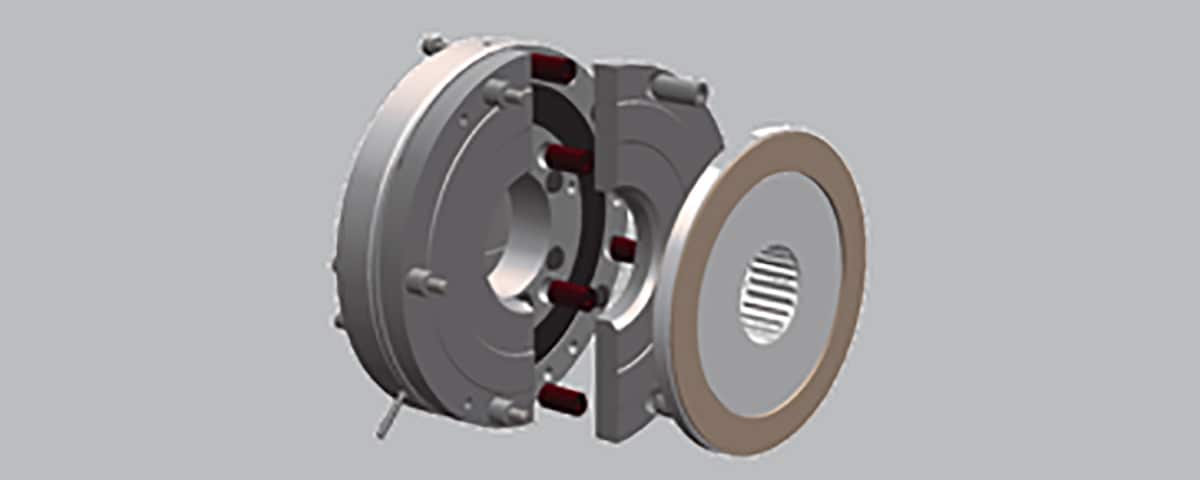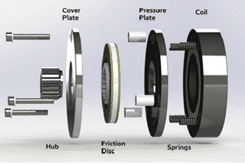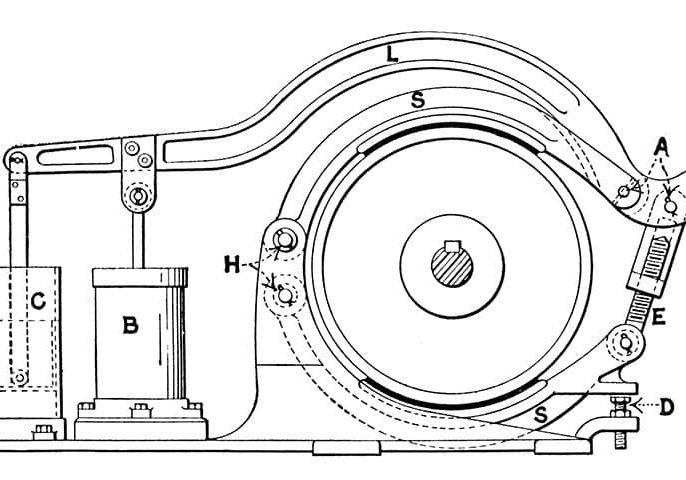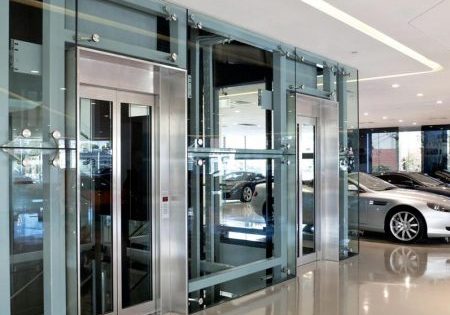Your author explains the top eight similarities and differences of these elevator brake types.
The braking system in an elevator or hoist is not often seen by passengers, but they absolutely depend on it being properly designed and functioning reliably. We’ll discuss the top similarities and differences of three types of electromagnetic braking devices: unitized brakes, caliper brakes and drum brakes. The motor will do most of the dynamic braking, but these brakes are capable of stopping or engaging an emergency stop, as well.
Similarities and Differences
Similarities:
- Safety
- Transmit torque mechanically
- Electromagnetic actuation
- Air gaps matter
- High reliability
- Manual release for service
- Redundant design
- Power-off design
Differences:
- Stopping or just holding, and emergency stops (e-stops)
- Fixed vs. variable torque
- Torque range
- Space needed
- Noise
- Mounting
- Maintenance
- Power usage
Details
Similarities
Safety: Power-off brakes are safety devices on moving equipment. If power is lost unexpectedly, the brake engages and stops motion. Before lawyers got involved, these were called fail-safe devices because they were designed to fail in the safe (braking) condition. If you ever wondered what was holding you in place while perched 50 stories in the air, it is the power-off brake.
Transmits torque mechanically: Spring-applied brakes transmit torque mechanically, although they are actuated electrically or hydraulically. The springs inside each brake apply a normal force at some distance, which relates to your stopping or holding torque. Torque = Force x Distance.
In a unitized brake (motor brake), the springs force the friction disc to be squeezed between the pressure plate and the cover plate. The friction disc is connected to a hub connected to the shaft, so by keeping the friction disc from turning, you keep the shaft from turning, as well.
In a caliper brake, the normal spring force is in the brake shoe. The shoe is mounted rigid and surrounds a large rotating brake disc. When the springs press the brake pad against the disc, it creates friction and stopping/holding torque.
In a drum brake, the spring does similar work, but the brake pad makes contact with either the inner diameter (ID) or outer diameter (OD) of a drum that carries the cables.
Electromagnetic actuation: A power-off brake is normally engaged. To disengage it, power is applied to the field coil. This creates magnetic flux that travels across the air gap and proceeds to pull the brake pressure plate toward the coil. This compresses the springs and releases the brake. When the pressure plate is in contact with the coil, the magnetic circuit is strong and the brake stays disengaged. Some brakes can also be hydraulically actuated, but the trend is to utilize electric actuation for easier maintenance, higher reliability and lower cost.
Air gaps matter: Magnetic flux does not like to travel across air gaps. However, air gaps are necessary in the operation of a spring-applied device. Without an air gap, the brake would never disengage when power is applied. On the other hand, if the air gap is too large the brake will also fail to disengage because magnetic flux will not be able to travel the distance and pull the pressure plate toward the field coil. In other words, there is a minimum air gap required so that components do not excessively rub, and there is a maximum air gap because the magnetic flux has limits to the open space that it can travel.
High reliability: When properly selected and operated, elevator and hoist brakes last for millions of cycles. This is important for safety, as well as uptime and operating cost. Some brakes have wear indicators to signal when design life is expiring or when adjustments need to be made. Others are designed to have their air gaps checked manually to determine adjustment or end of life.
Manual release for service: Since power-off brakes need power to release the brake, it presents a challenge during service. So, there are manual release features to mechanically release the brake. These could be in the form of a lever or perhaps even release bolts. Functionally, their purpose is to physically press the pressure plate against the coil body and compress the springs so that the friction material is not making contact and delivering brake torque.
Redundant design: There are several redundancies for safety and reliability. When one component fails or weakens, another can operate to keep the brake operational. Springs are one example. While they are not common failure points, there are several springs contributing to the total torque. Redundant coils can be used. If one fails, the other still works. There are unitized brake designs that have two full brakes built into one package. For caliper and drum brakes, multiple brake shoes can be used to create redundancy so that if one fails, the others still safely deliver the needed torque.
Power-off design: For all the brake types mentioned, power is only consumed when the elevator is in motion. No power is required for the brakes to apply torque. That is why we call them power-off devices.
Differences
Stopping or just holding, and e-stops: Based on the friction material and the heat dissipation rates of a brake, they are categorized as brakes for stopping, or brakes only for holding and e-stops. A material with a high coefficient of friction might produce higher static torque, but it will be compromised on the wear rate. So, these are typically used for holding only or e-stop applications. For brakes that are more frequently used for dynamic braking, other friction materials are used that have better wear rates. They also might be somewhat larger to help heat dissipation, because dynamic stopping creates heat through mechanical friction.
Fixed vs. variable torque: Power-off unitized brakes mainly have fixed torque per size; however, some brakes have adjustment bolts to change the spring force and brake torque. These unitized brakes are normally mounted on the back end of a motor, so there is no way to add more than one brake to the system. The system torque is therefore fixed. On the other hand, caliper and drum brakes deliver fixed torque per device, but it is possible to add several devices to one system. For example, several caliper brakes can be mounted to a disc and several drum brakes can be mounted inside or outside of a drum. In this case, the total torque can be increased based on adding more brakes.
Torque range: Unitized brakes that are mounted on motors are available in very small sizes and up to thousands of lb-ft torque. Caliper brakes are a type that apply clamping force to a rotating disc. That clamping force can be 1,000-plus lb-ft, and torque depends on the radius of the disc and the number of caliper brakes installed. Most discs have a diameter of at least 15 in. but can be much larger. Drum brakes generally produce around 500 lb-ft torque when used on a drum just under 20-in. diameter. Again, multiple brakes can be used on one drum to multiply torque.
Space needed: Unitized brakes typically mount on the backside of a motor, so the motor would need a shaft present. The OD of the brake is normally less than the OD of the motor, so the available length is usually the only concern. Caliper brakes are mounted around a disc, so space is not restricted much and it is quite possible to mount three to four brakes on that disc, if necessary. Drum brakes naturally mount inside or outside a drum. Mounting inside is tougher to access, but it allows for less space requirements.
Noise: For unitized brakes, the noise usually comes from the brake disengaging, as the pressure plate attracts to the coil body. This occurs when power is applied. This is often not a desired sound, so internal noise-dampening features can be provided to reduce noise to 60 dBA or less. These are used in mini-machine room or machine-room-less elevators. Noise is less a concern with caliper or drum brakes.
Mounting: Unitized brakes mount on the motor shaft. Generally speaking, they need only be bolted to the motor. Caliper brakes must be bolted rigidly around the rotating disc. Special care must be made for alignment and proper airgaps. Drum brakes also need the same amount of care for airgaps and alignment to ensure not only proper torque, but also long life.
Maintenance: Airgaps are an essential feature of any brake. Unitized brakes typically have the airgap fixed at the factory, so there isn’t much to do except monitor the airgaps for wear over time. There are now devices available that remotely monitor the airgaps. Some low-profile unitized brakes are available with split designs to make service and replacement easier.
Caliper and drum brakes, on the other hand, require more frequent inspection and service. The brake pads tend to wear due to dynamic stopping, and that wear decreases the life of the brake. At some point, the airgaps will need to be reset. External drum brakes are easier to inspect and service, compared to internal drum brakes.
Power usage: While all types of brakes mentioned operate similarly, they will require varying amounts of power to disengage.
Airgaps on unitized brakes can be controlled at the factory, so power required can be optimized. Magnetic flux does not like to travel across air gaps, so tighter gaps result in lower power requirements.
Drum brakes and caliper brakes have airgaps that are set in the field. It is possible that power consumption can be greater because of the number of devices and the variation in air gaps and electrical actuation of the brake.
In Review
Electromagnetic brakes of any style have a long-established reputation as reliable safety devices in elevators and escalators. Regulations continue to guide the application and location of the brakes. Some require that the brake be located on the shaft nearest the elevator.
Typical unitized brakes are mounted on the motor and need the holding torque to be transmitted through the drivetrain and over to the drum cable or elevator drive shaft. Because a catastrophic gearbox failure could void the effectiveness of a motor brake, other considerations can be made. As mentioned earlier, redundancies can provide an extra layer of safety. Unitized motor brakes can be used as the primary brake and a secondary emergency braking system, like a drum or caliper brake, can be used in case of a motor brake failure.
Get more of Elevator World. Sign up for our free e-newsletter.
















